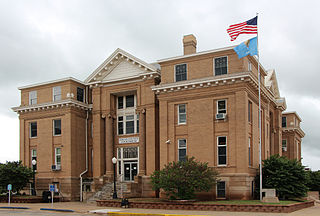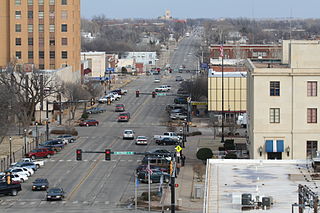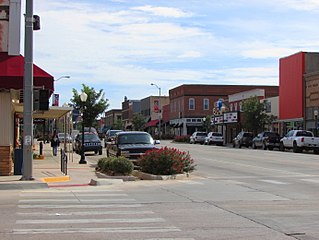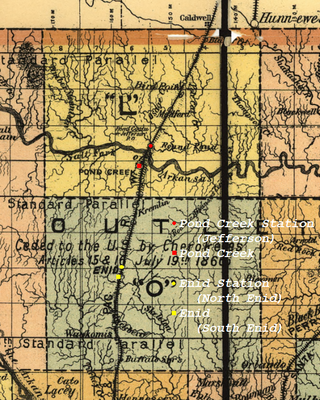Related Research Articles

Logan County is a county located in the U.S. state of Oklahoma. As of the 2020 census, the population was 49,555. Its county seat is Guthrie.

Garfield County is a county located in the U.S. state of Oklahoma. As of the 2020 census, the population was 62,846. Enid is the county seat and largest city within Garfield County. The county is named after President James A. Garfield.
Binger is a town in Caddo County, Oklahoma, United States. The population was 672 at the 2010 census. It is the headquarters of the Caddo Nation of Oklahoma, who were settled in the area during the 1870s.

Enid is the ninth-largest city in the U.S. state of Oklahoma. It is the county seat of Garfield County. As of the 2020 census, the population was 51,308. Enid was founded during the opening of the Cherokee Outlet in the Land Run of 1893, and is named after Enid, a character in Alfred, Lord Tennyson's Idylls of the King. In 1991, the Oklahoma state legislature designated Enid the "purple martin capital of Oklahoma." Enid holds the nickname of "Queen Wheat City" and "Wheat Capital" of Oklahoma and the United States for its immense grain storage capacity, and has the third-largest grain storage capacity in the world.

Fairmont is a town in Garfield County, Oklahoma, United States. The population was 134 at the 2010 census, a decrease from 147 at the 2000 census.

Kingfisher is a city in and the county seat of Kingfisher County, Oklahoma,. The population was 4,903 at the time of the 2020 census. It is the former home and namesake of Kingfisher College. According to the Encyclopedia of Oklahoma History and Culture, Kingfisher is now primarily a bedroom community for people employed in Enid and Oklahoma City.
Meno is a town in Major County, Oklahoma, United States. The population was 235 at the 2010 census, a 20.5 percent increase from the figure of 195 in 2000.

The AT&L Railroad was started in May 1985 by Wheeler Brothers Grain Company operating about 49 miles (79 km) of former Chicago, Rock Island and Pacific Railroad (CRI&P) track in Oklahoma. It replaced the North Central Oklahoma Railway, which operated the track between 1983 and 1985. The ATLT is based in Watonga, Oklahoma. It is owned by Wheeler Brothers Grain Company. The railroad is named for Austin, Todd and Ladd Lafferty, grandsons of E. O. (Gene) Wheeler, who founded the railroad.
The Oklahoma, Kansas and Texas Railroad (OKT) was a railroad operating in its namesake states in the 1980s.

The Enid–Pond Creek Railroad War occurred in Oklahoma Territory between 1893 and 1894, and pitted the citizens of two United States designated county seats against the Rock Island Railroad.
The Blackwell, Enid and Southwestern Railway (BES) was built as a short line railroad operating in Kansas, Oklahoma, and Texas.
The Denver, Enid and Gulf Railroad (DE&G) was built as a short line railroad operating in Kansas, and Oklahoma. Incorporated in Oklahoma as the Denver, Enid and Gulf Railroad Company, March 31, 1902, by the five Frantz Brothers.
The Choctaw, Oklahoma and Gulf Railroad (CO&G), known informally as the "Choctaw Route," was an American railroad in the states of Arkansas and Oklahoma.

The Railroad Museum of Oklahoma is a railroad museum located in the former Atchison, Topeka and Santa Fe Railway freight depot in Enid, Oklahoma. The museum began in 1977 and is a non-profit operated by the Enid chapter of the National Railway Historical Society. The freight depot was listed on the National Register of Historic Places in 2015.
The Enid and Tonkawa Railway was incorporated on July 20, 1899, under the laws of the Territory of Oklahoma. The company constructed a railroad line from North Enid, Oklahoma to Billings, Oklahoma, 26.7 miles, in that year. Passing through what would become the town of Breckinridge, Oklahoma, the line would in the future intersect the tracks of the Blackwell, Enid and Southwestern Railroad, built though that same location in the 1900-1901 timeframe.
The Lawton, Wichita Falls and Northwestern Railway was an effort around the time of Oklahoma statehood to build a railroad from Lawton, Oklahoma to Wichita Falls, Texas, about 100 miles. Despite a company being organized and bonds issued, no rails were actually laid.
The Oklahoma City and Western Railroad, together with its affiliate the Oklahoma City and Texas Railroad, built a line from Oklahoma City through Lawton, Oklahoma and on to Quanah, Texas in the 1901-1903 timeframe. By the time of its completion, the line was owned by the St. Louis-San Francisco Railway (Frisco), and all assets were absorbed into the Frisco in 1907.
The Eastern Oklahoma Railway was incorporated under the laws of Oklahoma Territory on July 24, 1899. The railroad constructed much of its own track. This included Guthrie junction to Cushing junction, 47.9 miles, in the 1900-1902 timeframe; Ripley to Esau Junction, 40.4 miles, also in the 1900-1902 timeframe; Newkirk to Pauls Valley, 182.5 miles, in the 1900-1904 timeframe; and, Davis to Sulphur, 9.3 miles, in 1906.
The Kiowa, Chickasha and Fort Smith Railway (KC&FS) came about when the Atchison, Topeka and Santa Fe Railway (AT&SF) and the Chicago, Rock Island and Pacific Railroad decided to build an interchange linking their systems at a point halfway between the towns of Chickasha and Pauls Valley in what is now the State of Oklahoma. Toward that goal, the AT&SF incorporated The Kiowa, Chickasha and Fort Smith Railway Company in Kansas on July 13, 1899, which then built a line from Pauls Valley to what became the town of Lindsay, a distance of 24.2 miles, in the 1901-1903 timeframe. The line’s first operation was in December of 1903.
The Ozark and Cherokee Central Railway (O&CC) was formed under the name of the North Arkansas & Western Railway in 1899. At its maximum, it owned a standard gauge, single track line running between Fayetteville, Arkansas and Okmulgee, Oklahoma. Its assets were merged into the St. Louis and San Francisco Railway (Frisco) in 1907.
References
- ↑ Report of the Board of Railroad Commissioners, State of Kansas, Volume 17
- ↑ The Railway age, Volume 31, Page 223
- ↑ Beach, Frank C, The Americana: A Universal Reference Library.
- ↑ Thomas, C.L., "Enid and Anadarko Railway Act" Annotated Acts of Congress; Five Civilized Tribes and the Osage Nation, pages 27-43.